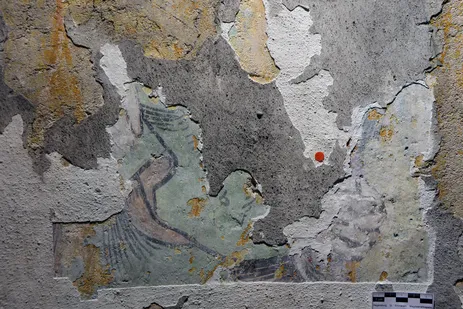Development of a Methodology for Non-Destructive Studies of Wall Paintings in Situ
The Palimpsest of the Magdalen Chapel of St. Emmeram, Regensburg

The overall aim of the project is the development of a non-destructive protocol for the examination of wall paintings in situ. The unique palimpsest of the Magdalen chapel of St. Emmeram, Regensburg, will be studied to optimize the methodology. The wall paintings in the Brandenburg cathedral cloister, already extensively studied, will be further investigated as a validation case.
The identification of the used materials and the assessment of their physico-chemical properties allow to assign individual layers to a specific painting phase, to identify later interventions, as well as to choose proper conservation-restoration strategies.
The material characterization of wall paintings, due to their inestimable value, complex stratigraphy as well as heterogeneous materiality, is challenging. From an analytical point of view, this means to acquire as much information as possible about organic and inorganic compounds while respecting the integrity of the artwork. The solution to such requirements is the use of non-destructive, complementary and portable analytical and digital tools.
The work plan includes the examination by conservators combined with archival research and digital documentation (photogrammetry, UV fluorescence photography, metigo®MAP). A double-sensor hyperspectral imaging system (range 400-2500 nm), a macro X-ray fluorescence scanner and a 3D digital microscope will be complemented by punctual analytical tools such as portable Raman and mid-infrared spectrometers for material characterization purposes. Infrared thermography and Terahertz spectroscopy will be applied to address conservation issues and to investigate hidden paint layers, respectively.
The imaging systems that are able to register spatially resolved spectra will be used to create mappings of different elements/compounds across the surface. The visualization of patterns that otherwise are not recognisable will be extremely important to answer conservation and art-technological queries. Despite their great potential for cultural heritage studies, these methods are not yet routinely applied in the field due to high costs, time-consuming implementation and the complexity of the generated data.
Milestones of the project will be the optimization of the analytical methods for in situ measurement campaigns, the creation of multimodal spectral databases for historical materials and the implementation of a user-friendly data treatment protocol.
Our research will introduce state-of-the-art techniques in the conservation-restoration practice. The project is based on a strong interdisciplinary interaction among conservation-restoration and material sciences. The findings will assure the basis for further research, e.g. in the field of art history.
The wall paintings of the Magdalen chapel will be legible and accessible also for the general public. The visibility of the chapel in the context of the UNESCO World Heritage Site of Regensburg will thus be enhanced.

Funding:
Deutsche Forschungsgemeinschaft e. V. (German Research Foundation, DFG)
Duration:
September 2022 – August 2025
| Project leader: Dr. Clarimma Sessa | Co-responsible: Prof. Dr. phil. dott. Thomas Danzl | Project collaborator: M.A. Nadia Thalguter |
Tandem project:
„Hyperspektrale Untersuchungsmethoden und die Entwicklung einer digitalen Toolbox für die Erforschung und Vermittlung fragmentarischer Wandmalerei“, HAWK Hildesheim/Holzminden/Göttingen
Prof. Dr. phil. Dipl.-Rest. Ursula Schädler-Saub, Dipl.-Rest. M.A. Sabine Krause-Riemer


